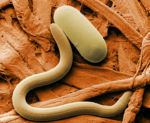Helminths Introduction
The term helminth is commonly used to describe parasitic worms, all with eukaryotic cell structures. The two main groups are the Nematodes (roundworms) and the Platyhelminthes (flatworms).
- Nematodes: typically long and slender, the nematodes are dioecious (male and female individuals) and are generally found attached to the intestinal wall
- Hookworms- widely endemic in the tropics, hookworms hatch on soil and enter the host through the feet. Pathogenesis involves intestinal irritation and haemorrhage.
- Giant roundworms- found worldwide, hosts are infected by ingesting eggs from faeces of infected individuals. Symptoms include intestinal irritation and malnutrition
- Pinworms- found in temperate areas, eggs hatch in the intestine after ingestion
- Pork worm- found worldwide, pork worms can infect most carnivorous animals, causing trichinosis.
- Filarial worms- various species found in tropical and subtropical areas depending on distribution of insect vectors, causes allergic reactions and potentially blindness
- Platyhelminthes
- Trematodes- commonly known as the 'flukes,' trematodes are non-segmented and have alternate sexual and non-sexual generations in different hosts. They are mostly hermaphroditic except the blood flukes, which are dioecious.
- Cestodes- commonly known as the 'tapeworms,' these consist of an enlarged head section ('scolex'), with suckers or hooks for attachment in the intestine and successive flat segments forming a chain of 'proglottids'

